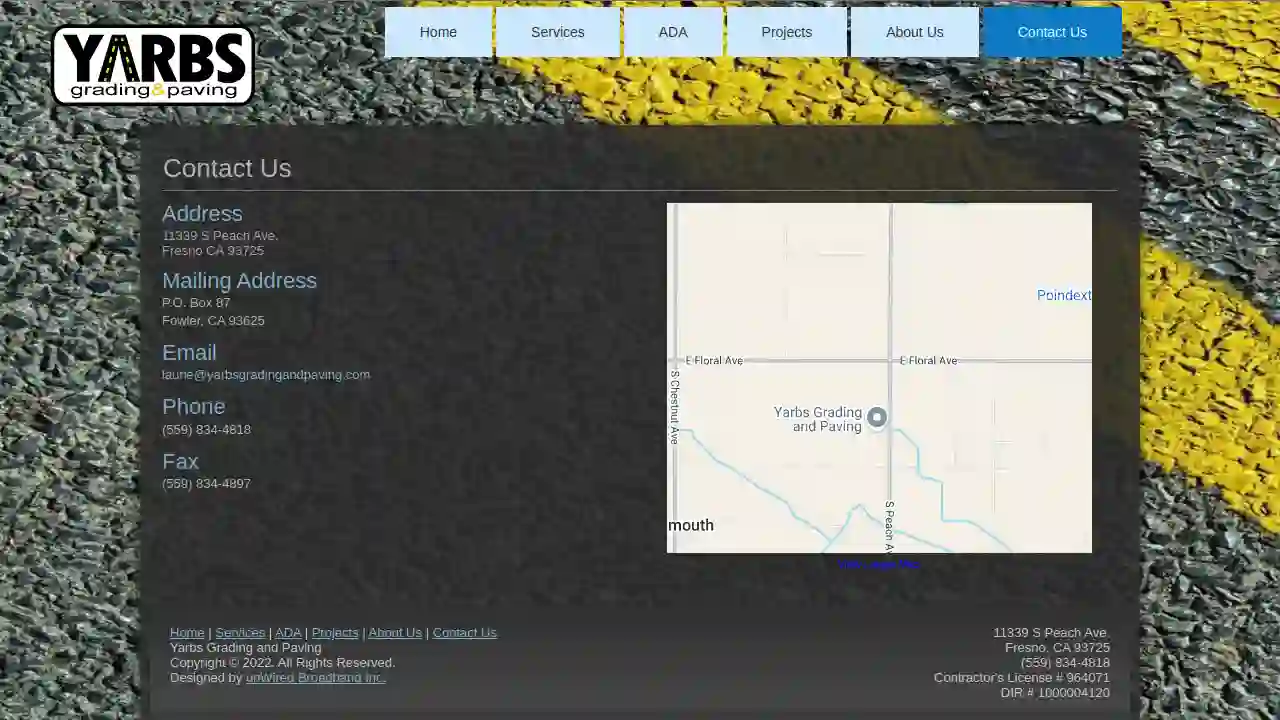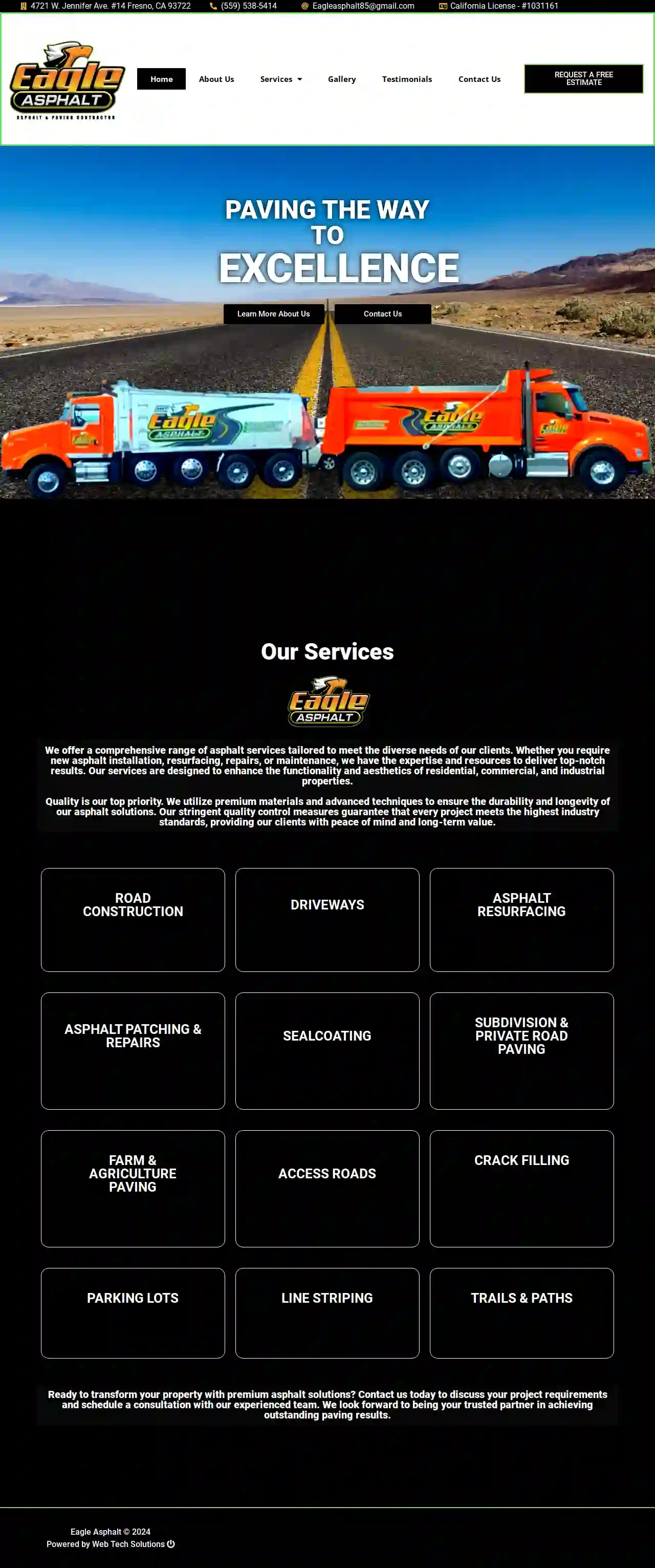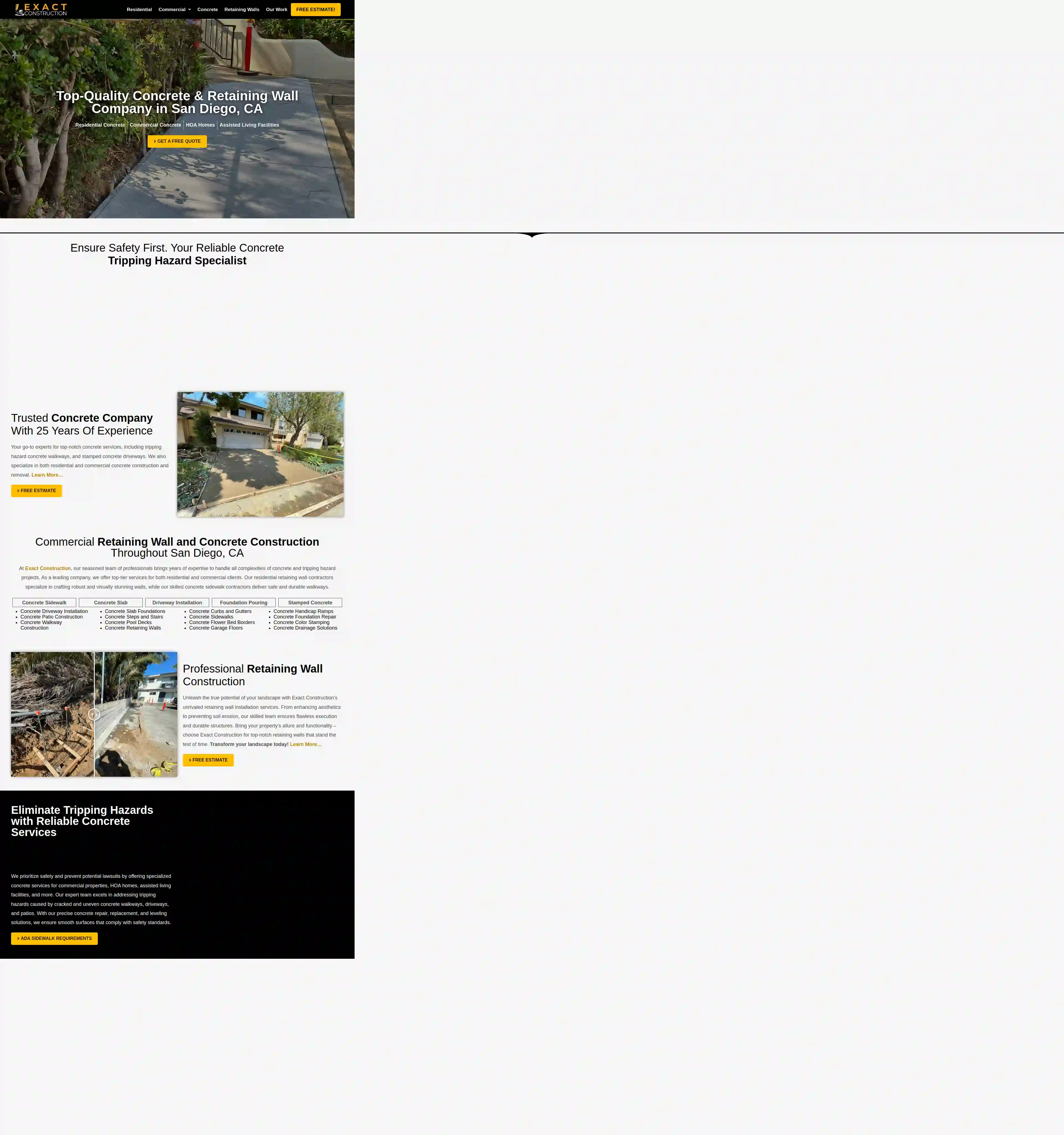Dirt Contractors Antioch
Find Dirt Removal in Antioch
Receive 3 FREE Dirt Contractors quotes for your project today! Compare profiles, reviews, accreditations, portfolio, etc... and choose the best deal.

Yarbs Grading and Paving
55 reviews11339 S Peach Ave., Fresno, 93725, USYarbs Grading and Paving: Your Trusted Partner for Quality Construction Yarbs Grading and Paving is a full-service grading and paving company located in Fresno, California. We have over 20 years of experience and are committed to delivering quality projects that meet or exceed our customers' expectations. We specialize in parking lot construction, ADA improvements, and city, county, and state roadway construction. Our team is dedicated to providing exceptional service and ensuring that every project is completed on time and within budget. We take pride in our work and strive to build lasting relationships with our clients. We offer a wide range of services, including: Concrete improvements Asphalt paving and overlays Mass excavation Underground Demolition Seal coating Striping We serve Fresno, Clovis, Madera, and the surrounding areas. Contact us today to discuss your project needs.
- Services
- Why Us?
Get Quote
Controlled Environments Construction, Inc.
11562 Parkway Loop, Suite E, Tustin, 92780, USControlled Environments Construction (CEC) is your one-stop shop for everything you need when considering a new or remodeled cold storage warehouse, food processing facility, pharmaceutical cold / clean room, waste-water lagoon, industrial warehouse roof-raising or any other project. We've had the pleasure of working with a wide range of clients, from small businesses to large corporations, and we're always happy to help our clients achieve their goals. We're committed to providing our clients with the highest quality construction services, and we're always striving to improve our processes and procedures. We're proud of our work, and we're confident that we can provide you with the same level of quality and service that we've provided to our other clients. Contact us today to learn more about our services and how we can help you with your next project.
- Services
- Why Us?
- Gallery
Get Quote
Burchett Grading, Inc.
4.47 reviewsPo Box 892863, Temecula, 92589, USABOUT US Burchett Grading, Inc. is a full service grading and excavation company that has been in business for almost 50 years. President, Craig Burchett is a third generation heavy equipment operator. Coming from a family of farmers, the family business was started by his father, Gene Burchett back in the 1970's and he was known in the industry as one of the best operators around. Starting mainly as an AG prep contractor, most of the avocado groves were prepped by Gene, as he was one of the only graders in town that would clear and prep the steepest hills. Beyond that, Gene was a mainstay hired heavy equipment operator contracted with Cal-Fire and shifted his focused on residential house pads. Craig followed in his dad's footsteps and quickly developed his father's keen eye for dirt. In the recent years, BGI expanded it's services to more than just grading, but undertaking the entirety of civil plans and offering more diverse services such as storm drain and wet/dry utilities. Craig brings his extensive knowledge, experience, integrity and passion for dirt work that leaves nothing less than exceptional results. Our priority is to oversee your project, big or small, from start to finish, and to ensure that everything goes smoothly and is done right the first time. Our mission is to exceed your expectations. We would love the opportunity to work with you and look forward to hearing from you! OUR MISSION We know how challenging and daunting construction projects can be. This is why it is crucial to have the right contractor that can help face these challenges and give you the results you need. We are committed to excellence and the job at hand is always our top priority. We believe integrity, knowledge and extensive experience is the driving force of a successful construction project and we strive to attain nothing less. Whatever your vision may be, we are here to ensure your vision is carried out.
- Services
- Why Us?
- Gallery
Get Quote
Eagle Asphalt - Asphalt & Paving Contractor
4.920 reviews4721 W. Jennifer Ave., #14, 4721 W. Jennifer Ave. #14, Fresno, 93722, USEagle Asphalt CA Eagle Asphalt proudly offers a wide range of services, we are your one-stop pavement and asphalt solution! Whether it be an asphalt overlay, new asphalt construction, or asphalt repair, Eagle Asphalt in Fresno, California has the experience and expertise to see the job through from start to finish. Give us a call… today! Eagle Asphalt in Fresno, CA is Locally Owned, Licensed & Insured. Serving Central Valley.
- Services
- Why Us?
- Our Team
- Testimonials
- Gallery
Get Quote
KR Land Development LLC: Land Clearing and Site Prep
516 reviewsOrange, USAbout KR Land Development At KR Land Development, our mission is to transform natural landscapes into safe, sustainable, and accessible spaces. With a deep respect for the environment and a commitment to efficiency, we provide expert land clearing services that pave the way for responsible land development. Our goal is to balance the needs of our clients with the preservation of nature, delivering innovative solutions that create a harmonious coexistence between humanity and the land. We are dedicated to improving the accessibility, safety, and utility of our clients’ properties while minimizing our impact on the environment. By aligning cutting-edge technology with eco-conscious practices, we aim to be leaders in the industry, leaving a legacy of well-cleared land and a healthier planet for future generations. Ready to Get Started On Your Land Clearing Project? We've Got You Covered! If you are looking to get started on your next land clearing project, we are here to help! KR Land Development offers free consultations to every client that is interested in our land clearing or property services. We are licensed & insured, protecting our clients and their property at all times throughout the land clearing process.
- Services
- Why Us?
- Gallery
Get Quote
Exact Construction
49 reviewsVista, USAbout Our Company Exact Construction is a trusted demolition and concrete company in San Diego, CA. We specialize in concrete and tripping hazard projects for both residential and commercial clients. Our team of experienced professionals brings years of expertise to every project, ensuring quality and safety. Our Mission At Exact Construction, we are committed to providing our clients with the highest quality concrete services. We strive to exceed expectations by delivering exceptional craftsmanship, timely completion, and outstanding customer service. Our goal is to build lasting relationships with our clients, based on trust, integrity, and a shared commitment to excellence. Our Values Our core values guide everything we do. We believe in: Integrity: We operate with honesty and transparency in all our dealings. Quality: We are committed to delivering exceptional craftsmanship and exceeding client expectations. Safety: We prioritize the safety of our employees, clients, and the public. Customer Focus: We are dedicated to providing outstanding customer service and building lasting relationships. Innovation: We embrace new technologies and techniques to enhance our services and deliver the best possible results.
- Services
- Why Us?
- Our Team
- Gallery
Get Quote
Optimal EarthWork
51 reviews3070 Garden Ave, San Jose, 95111, USTransforming Landscapes with Precision: Earthworks Experts We harness the raw potential of the earth to create extraordinary transformations and deliver awe-inspiring results for every project we undertake. Excavation & Grading Swimming Pool Demolition Demolition
- Services
- Why Us?
- Accreditations
- Our Team
- Testimonials
- Gallery
Get Quote
VC Construction
1Bakersfield, USAbout VC Construction Located in the beautiful mountain community of Tehachapi CA, Kern County, VC Construction first began as a sole proprietorship, owned and operated by Vic and Jopha Calanchini, licensed in the state of California in 2007 as a general building contractor, later adding on additional licensing in earthwork (C-12) and fencing (C-13). The company continued to grow and in 2013 the business was established as a corporation, now known as, Calanchini Inc dba VC Construcion, by owners Vic Calanchini, Pres./CEO and Jopha Calanchini, VP/Sec. VC Construction has built a reputation of quality work, making sure the job is done right the first time. We also deliver construction solutions that go beyond a finished project, giving our clients exceptional service. VC Construction takes a responsible approach to every project and is dedicated to bringing our clients maximum cost savings while minimizing the environmental impact at every stage of work. Our management team strives to complete projects punctually and ahead of schedule providing ideal outcomes for our valued clients. Safety is a must! VC Construction ensures a safe work environment by developing and enforcing comprehensive workplace practices. Every employee, staff and crew members are required to attend safety meetings, training programs, and be familiar with OSHA safety regulations. VC Construction prides itself by our creativity, to think "outside of the box", and to deliver winning solutions for our clients. Our work is our art and we demonstrate that by showing attention to detail, and giving the highest quality behind every client account and company project.
- Services
- Why Us?
- Our Team
- Gallery
Get Quote
JPI Development Group, Inc.
44 reviewsTemecula, US- Services
- Why Us?
Get Quote
Beaver Land Clearing LLC
52 reviews3980 Lake Mary Boulevard, 3980 E Lake Mary Blvd., Sanford, 32773, USOur Story At Beaver Land Clearing, we provide a comprehensive range of services, including Tree Services in Sanford, Land and Lot Clearing, Commercial Landscaping in Lake Mary, and Tree Services in Lake Mary. We also offer professional Excavator Contractor, Bobcat, and Aerial Boom Lift Services. Our commitment to excellence drives us to consistently exceed our customers' expectations. Our Services We offer a wide array of services, encompassing Tree Services in Sanford, Land and Lot Clearing, Commercial Landscaping in Lake Mary, Tree Services in Lake Mary, and Lawn Maintenance. Our skilled team possesses the necessary tools and expertise to handle any project, regardless of size. Contact us today at (386-216-2208) to discuss your needs. Our Process At Beaver Land Clearing, we believe in a personalized approach to deliver exceptional results. We collaborate with you to develop a tailored plan, whether it's a manual or 3D Landscape Design, that aligns with your specific requirements and budget. Our team then executes the plan with precision and care, ensuring your trees, land, and landscaping are healthy and aesthetically pleasing. Commercial And Residential Beaver Land Clearing provides expert Tree Services in Sanford, Commercial Landscaping in Lake Mary, and Land and Lot Clearing services. We also offer emergency services for Storm Disasters and Storm prep. We're here to assist you with all your tree care and landscaping needs.
- Services
- Why Us?
- Gallery
Get Quote
Over 3,943+ Excavation Companies in our network
Our excavation providers operate in Antioch and surroundings!
ExcavationHQ has curated and vetted Top Excavation Contractors arround Antioch. Find a trustworthy pro today.
Frequently Asked Questions About Dirt Contractors
- Online Directories: Utilize online directories like ExcavationHQ that specialize in connecting homeowners and businesses with qualified contractors. You can filter your search by location, service type, and read reviews from previous customers.
- Referrals: Ask friends, family, neighbors, or colleagues for recommendations based on their experiences with dirt contractors.
- Local Building Supply Stores: Inquire at local building supply stores, as they often have connections with contractors in the area.
- Online Reviews: Check online review platforms like Google My Business, Yelp, and Angie's List for insights into contractor reputations and customer feedback.
- Environmental Site Assessment: Hire a qualified environmental consultant to conduct a Phase I Environmental Site Assessment (ESA). This involves reviewing historical records, conducting site reconnaissance, and interviewing relevant parties to identify potential environmental concerns.
- Soil Sampling and Testing: If the ESA indicates potential contamination, soil samples will be collected and analyzed in a laboratory for the presence of specific contaminants, such as heavy metals, pesticides, or petroleum products.
- Dirt Removal: Excavating and hauling away excess dirt or soil from construction sites, landscaping projects, or other areas.
- Dirt Delivery: Transporting and delivering various types of dirt, such as topsoil, fill dirt, sand, or gravel, for construction, landscaping, or gardening purposes.
- Grading: Leveling or sloping land to achieve specific contours for drainage, landscaping, or construction projects.
- Excavation: Digging trenches, foundations, basements, pools, or other structures requiring earthmoving.
- Land Clearing: Removing trees, vegetation, and debris to prepare land for development or other uses.
- Site Preparation: A combination of services, including clearing, grading, and compaction, to prepare a site for construction or landscaping.
What is the difference between topsoil and fill dirt?
Topsoil: The uppermost layer of soil, characterized by its rich organic matter content, nutrients, and dark color. It's essential for supporting plant growth and is commonly used for gardening, landscaping, and lawn establishment.
Fill Dirt: Primarily composed of subsoil or excavated materials, generally lacking the organic matter and nutrients found in topsoil. It's typically less fertile and used for structural purposes, such as filling in low areas, leveling ground, or creating raised beds.
Understanding the difference between topsoil and fill dirt is crucial for choosing the appropriate soil type for your specific project needs.
How do I find a reputable dirt contractor near me?
How do I know if the dirt I need is contaminated?
What services do dirt contractors provide?
What is the difference between topsoil and fill dirt?
Topsoil: The uppermost layer of soil, characterized by its rich organic matter content, nutrients, and dark color. It's essential for supporting plant growth and is commonly used for gardening, landscaping, and lawn establishment.
Fill Dirt: Primarily composed of subsoil or excavated materials, generally lacking the organic matter and nutrients found in topsoil. It's typically less fertile and used for structural purposes, such as filling in low areas, leveling ground, or creating raised beds.
Understanding the difference between topsoil and fill dirt is crucial for choosing the appropriate soil type for your specific project needs.
How do I find a reputable dirt contractor near me?
- Online Directories: Utilize online directories like ExcavationHQ that specialize in connecting homeowners and businesses with qualified contractors. You can filter your search by location, service type, and read reviews from previous customers.
- Referrals: Ask friends, family, neighbors, or colleagues for recommendations based on their experiences with dirt contractors.
- Local Building Supply Stores: Inquire at local building supply stores, as they often have connections with contractors in the area.
- Online Reviews: Check online review platforms like Google My Business, Yelp, and Angie's List for insights into contractor reputations and customer feedback.
How do I know if the dirt I need is contaminated?
- Environmental Site Assessment: Hire a qualified environmental consultant to conduct a Phase I Environmental Site Assessment (ESA). This involves reviewing historical records, conducting site reconnaissance, and interviewing relevant parties to identify potential environmental concerns.
- Soil Sampling and Testing: If the ESA indicates potential contamination, soil samples will be collected and analyzed in a laboratory for the presence of specific contaminants, such as heavy metals, pesticides, or petroleum products.
What services do dirt contractors provide?
- Dirt Removal: Excavating and hauling away excess dirt or soil from construction sites, landscaping projects, or other areas.
- Dirt Delivery: Transporting and delivering various types of dirt, such as topsoil, fill dirt, sand, or gravel, for construction, landscaping, or gardening purposes.
- Grading: Leveling or sloping land to achieve specific contours for drainage, landscaping, or construction projects.
- Excavation: Digging trenches, foundations, basements, pools, or other structures requiring earthmoving.
- Land Clearing: Removing trees, vegetation, and debris to prepare land for development or other uses.
- Site Preparation: A combination of services, including clearing, grading, and compaction, to prepare a site for construction or landscaping.